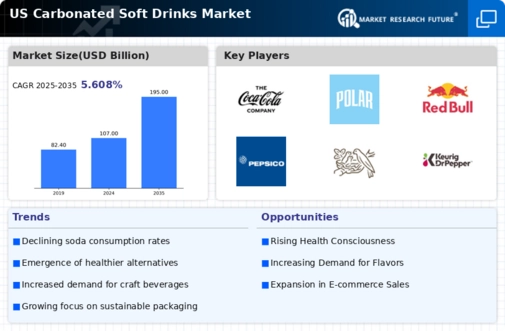Innovative Flavor Offerings
The carbonated soft-drinks market is experiencing a surge in innovative flavor offerings, which appears to be a key driver of consumer interest. Companies are increasingly experimenting with unique and exotic flavors, catering to diverse palates. This trend is particularly evident in the introduction of limited-edition flavors and collaborations with popular brands. For instance, the market has seen a rise in fruit-infused sodas and beverages that incorporate spices or herbs. This diversification not only attracts adventurous consumers but also encourages brand loyalty. As a result, the market is projected to grow at a CAGR of approximately 4.5% over the next five years, driven by these novel flavor profiles.
Convenience and On-the-Go Consumption
The fast-paced lifestyle of consumers in the carbonated soft-drinks market is driving the demand for convenient packaging and on-the-go consumption options. Single-serve cans and bottles are increasingly popular, as they cater to busy individuals seeking quick refreshment. Retailers are responding by optimizing shelf space for grab-and-go products, which enhances visibility and accessibility. Additionally, the rise of e-commerce has facilitated the purchase of carbonated beverages, allowing consumers to stock up on their favorites with ease. This shift towards convenience is expected to contribute to a steady growth rate of around 3.8% in the market, as more consumers prioritize efficiency in their purchasing habits.
Brand Loyalty and Marketing Strategies
Brand loyalty plays a crucial role in the carbonated soft-drinks market, as established brands leverage their reputation to maintain a competitive edge. Companies invest heavily in marketing strategies that resonate with their target demographics, utilizing social media, influencer partnerships, and experiential marketing to engage consumers. Promotions and loyalty programs further incentivize repeat purchases, fostering a sense of community among brand enthusiasts. Recent data indicates that approximately 60% of consumers express a preference for familiar brands over new entrants, highlighting the importance of brand recognition. This loyalty is likely to sustain market growth, with projections indicating a potential increase of 5% in sales driven by effective marketing initiatives.
Healthier Alternatives and Reformulation
In response to shifting consumer preferences, the carbonated soft-drinks market is witnessing a trend towards healthier alternatives and reformulation of existing products. Many companies are reducing sugar content and incorporating natural sweeteners to appeal to health-conscious consumers. This reformulation strategy not only addresses growing concerns about obesity and diabetes but also aligns with the increasing demand for transparency in ingredient sourcing. As a result, the market is seeing a rise in low-calorie and zero-sugar options, which are gaining traction among consumers. Industry reports suggest that these healthier offerings could account for up to 30% of total sales in the coming years, reflecting a significant shift in consumer behavior.
Emerging Market Segments and Demographics
The carbonated soft-drinks market is evolving with the emergence of new market segments and changing demographics. Younger consumers, particularly millennials and Gen Z, are driving demand for innovative and unique beverage experiences. This demographic is more inclined to explore niche brands that offer artisanal or craft options, often prioritizing quality over quantity. Additionally, the increasing diversity of the population is influencing flavor preferences and product offerings. Companies are adapting their marketing strategies to cater to these emerging segments, which may lead to a broader range of products that reflect cultural influences. This shift is anticipated to contribute to a market growth rate of approximately 4% as brands seek to capture the attention of these dynamic consumer groups.



















Leave a Comment